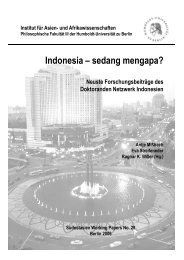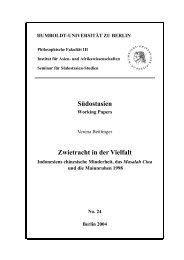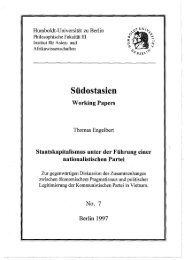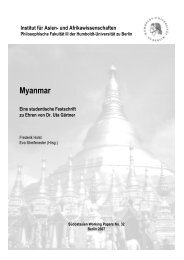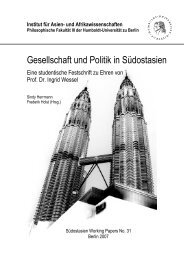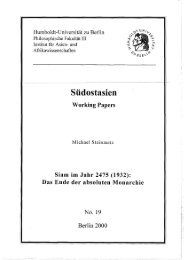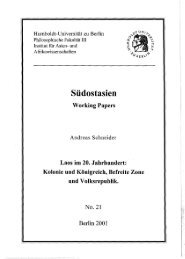Connecting the Philippines and Germany - HU Berlin
Connecting the Philippines and Germany - HU Berlin
Connecting the Philippines and Germany - HU Berlin
Create successful ePaper yourself
Turn your PDF publications into a flip-book with our unique Google optimized e-Paper software.
Rizal now takes <strong>the</strong> opportunity to point out, in a footnote, that <strong>the</strong> indigenous foundry run by P<strong>and</strong>ay<br />
Pira disappeared after <strong>the</strong> Spanish settled in Manila, conquered from <strong>the</strong> indios:<br />
“This demonstrates that, when <strong>the</strong> indio P<strong>and</strong>apira died, <strong>the</strong>re were no Spaniards who knew how to do<br />
what he did, nor were his children as skilled as <strong>the</strong>ir fa<strong>the</strong>r.” 36<br />
Today P<strong>and</strong>ay Pira, <strong>the</strong> cannon-founder, joins <strong>the</strong> Pan<strong>the</strong>on of Heroes <strong>and</strong> o<strong>the</strong>r “great” Filipinos who<br />
are immortalized in school textbooks, despite historical <strong>and</strong> archaeological avidence to <strong>the</strong> contrary. In<br />
Retana’s edition of Morga, his long footnotes on P<strong>and</strong>apira contain transcriptions of sixteenth century<br />
archival documents from Seville which refute Rizal’s assertions that cannon-making was a flourishing<br />
indigenous industry. The documents from <strong>the</strong> colonial government in Manila requesting higher authorities<br />
in Mexico to send cannon makers show that <strong>the</strong> Filipinos were unable to forge <strong>the</strong> thick<br />
European-style cannons.<br />
A letter from Governor Vera on June 26, 1587 to <strong>the</strong> Viceroy in Mexico gives an account of his artillery<br />
<strong>and</strong> requests more.<br />
“I cannot find anyone who knows how to found cannons, because those provided are by indios who<br />
“...hizo casa de fundicion de artilleria en Manila, donde (por falta de maestros fundidores) se acertaron<br />
pocas piecas gruessas.”<br />
“Esto demuestra que, muerto el indio P<strong>and</strong>apira, no habia Españoles que supieran hacer lo que aquel,<br />
ni los hijos serian tan habiles como el padre.” cannot make large cannons. I request Your Excellency<br />
to send from New Spain founders <strong>and</strong> officers to manufacture cannons.” 37<br />
Retana continues, “This is to say, that <strong>the</strong> natives did not know how to found large cannons. The 26<br />
large pieces alluded to by de Vera could very well come from <strong>the</strong> Spanish ships or those well-made by<br />
Robles, <strong>the</strong> Spanish master founder. If P<strong>and</strong>ay Pira <strong>and</strong> his sons were indeed such experts at making<br />
large cannons <strong>the</strong>re would be no reason for de Vera’s request.” 38<br />
Robles, he notes elsewhere, died before 1587. Thus, his arrival in <strong>the</strong> <strong>Philippines</strong> could be dated to<br />
about 1575-1576. Retana takes Filipino historians—above all Rizal—to task for trying to claim too<br />
much from so little, by insisting that cannon-making was a flourishing indigenous industry. The<br />
documents he cites prove o<strong>the</strong>rwise.<br />
Retana has more to say. He cites an ethnographic article by Blumentritt (whose opinion was held in<br />
high esteem by Rizal <strong>and</strong> o<strong>the</strong>r Filipino writers) which stated that <strong>the</strong> pre-Hispanic foundry <strong>the</strong> Spaniards<br />
encountered in Manila was run by a Portuguese cannon-maker! It is odd that Rizal, who read<br />
practically every word Blumentritt had written on <strong>the</strong> <strong>Philippines</strong>, overlooked an important line in<br />
Filipinas en tiempo de la Conquista, 39 which states that <strong>the</strong> Portuguese taught <strong>the</strong> Tagalogs <strong>the</strong> founding<br />
of cannons. Blumentritt states fur<strong>the</strong>r that cannons were brought to <strong>the</strong> <strong>Philippines</strong> by Portuguese<br />
adventurers <strong>and</strong> deserters, challenging <strong>the</strong> opinion of o<strong>the</strong>r scholars who maintained that this “indigenous”<br />
industry could trace its provenance to Borneo.Retana gives <strong>the</strong> coup de grace :<br />
“...in a word, in <strong>the</strong> art of metallurgy with relation to <strong>the</strong> founding of cannons, <strong>the</strong> Filipinos did not<br />
retrogress, on <strong>the</strong> contrary, <strong>the</strong>y gained, thanks to <strong>the</strong> training given by <strong>the</strong> Spaniards.” 40<br />
36 Loc. cit. note 4.<br />
37 Op cit, p. 406.<br />
38 Loc. cit.<br />
39 Boletin de la Sociedad Geografica. Tomo XXI. Madrid: 1886, p. 217.98 rotten beef <strong>and</strong> stinking fish: Rizal <strong>and</strong> <strong>the</strong> writing<br />
of Philippine History<br />
40 Retana-Morga, pp.418-419.<br />
15



